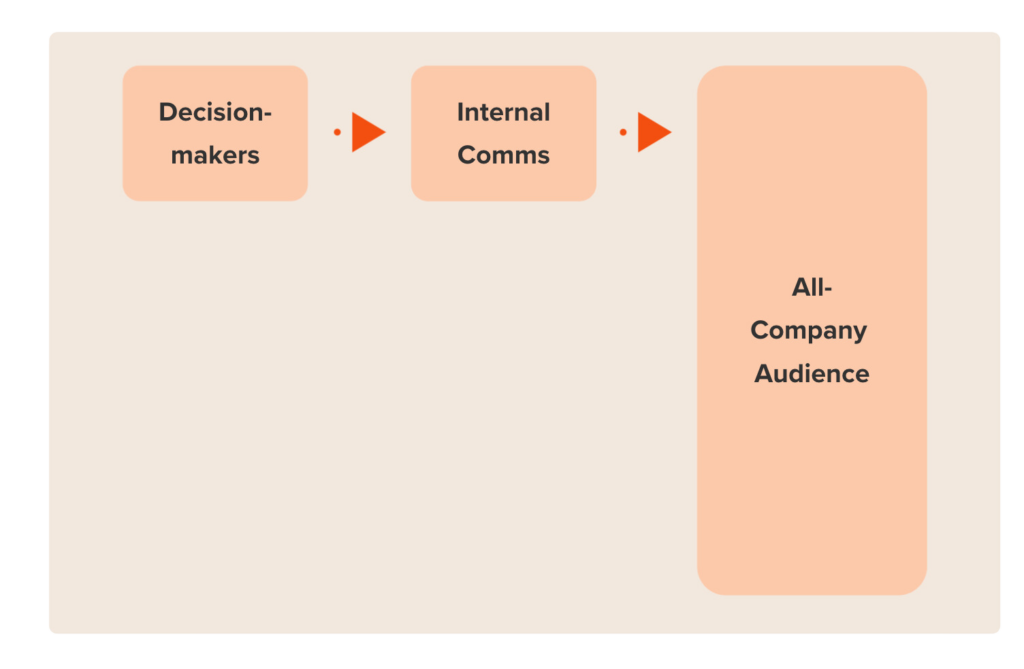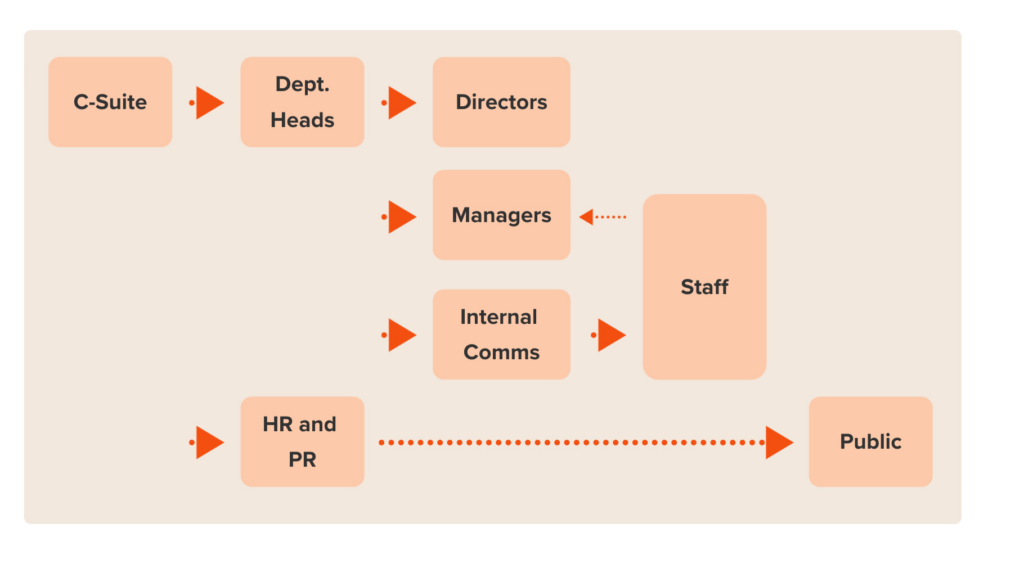How to use a communication cascade (+ a free template!)

Sharing important information with lots of people is not easy. In a company, with departments and titles and stakeholders and real consequences on the line, it’s very, very not easy. That’s why internal communications strategies take careful planning and thoughtful execution, every time.
Internal comms pros love to use the idea of a communication cascade, or waterfall approach, to visualize and plan out how information will flow through the organization. The waterfall idea helps, but it’s never – ever – quite as simple as “straight from top to bottom.” You need to think it through with a communication cascade template!

Why use a communication cascade?
Using the cascade communication model in an organization helps make sure that everyone gets the right information at the right time, and helps communicators see challenges before they come up.
Don’t miss anyone
Companies are complicated! A cascade plan makes sure that every group in the organization has a plan to get the correct information.
Target to audiences
Some messages can be the same for everyone in the org… some messages need lots of nuance. Your cascade plan will help you see the differences and plan your audience segmentation.
Focus on transparency
With a good information-sharing plan, everyone in the organization is getting consistent, clear comms. That builds trust and shows good faith from leadership and communication teams.
Build in feedback loops
Making in the plan in a cascade model also makes you think through anticipated questions and feedback. Providing and planning for the right channels and feedback-sharing creates a much smoother comms experience.
A communication cascade template
Our easy-to-use communication cascade template will help you plan and organize your message for every audience in your organization, and determine the order that you’ll share information in. Take a look –
What’s in this template?
The first tab in the Google Sheet is the cascade template itself. The second tab has a quick communications brief template. It’s a good idea to fill out the communications brief first, to make sure you’ve answered all the big questions about your project. The third tab is an example of how a company might fill out and alter the template for their new hybrid work policy announcement.
How to use this communications template
Step 1 – Complete your communications brief
A good communications brief is a simple set of questions designed to help you cover all the bases before you start doing stuff. Be sure you’ve answered these questions!
- Goals and objectives – why are we doing this?
- Audience – who are we doing this for?
- Key takeaways – what do we want audiences to know?
- Collaborators – who needs to be involved?
- Timeline – when do the important events happen?
Step 2 – Determine the stakes and audiences for your communication
Once you’ve answered the basic questions, it’s time to start planning the information cascade! The first thing to do is determine all of the individual audiences for your comms. In internal comms, this usually looks like organizational groups (leadership, directors, managers, frontline workers, human resources, the public, etc.).
- Mass audience
Most everyone gets the same message - Divided audiences
Different teams require different versions of the message - Controlled audiences
The message is high-change and requires careful couching in delivery
The second part we recommend thinking about is the stakes of what you’re saying – is this something with big consequences? Does it require special “couching” or extra attention with a certain group?
- Low stakes
Volunteering opportunities
Employee recognition
Special office days - Medium stakes
New or changed policies
Required trainings
Strategy updates - High stakes
Merger or acquisition
Layoffs
Major PR events
Step 3 – Group the audiences appropriately
Now it’s time to put all this thought into the cascade. The important thing to remember is not to add too many steps. Most information doesn’t need to be a complicated game of telephone or a relay race – you should always try to share with as many groups as possible at a time. We like to think of it in these three steps:

Let’s take a look at three examples of how that might happen.
The first example is low stakes/mass audience. This one is for a volunteering opportunity available to the whole company – everyone should know, but it isn’t going to change anyone’s work life.

You don’t need to overly structure comms like this – they should go out as widely as possible. Here, the team that made the decision (could be HR, leaders, any one else really) relays it to internal comms, who share it out to the all-company audience, probably through the newsletter. Everyone at all levels finds out and understands at the same time.
The next example is medium stakes/divided audiences. It’s for the announcement of a new hybrid work policy for the company. It will affect some groups a lot, some not so much, and the takeaways are likely to be very different for different audiences. A partially tiered structure will help make sure everyone gets what they need.

The decision is made at the leadership level and conveyed to department heads. They communicate with their individual leadership and internal comms at the same time, who are then equipped to do their part.
Internal comms releases the information to the staff, so that everyone hears it in the same time and in the same way. Managers are also equipped in this strategy to handle feedback, questions, and follow up. They’re the primary point of contact after the information is shared. Get way more tips for manager communications here!
Separately, the right departments are tasked with the details and the public announcement, which should always happen after EVERYONE in the company has been informed.
The last example is high stakes/controlled audiences. It’s the most planned-out, and follows a true cascade the closest. This is what someone might use for a pivotal leadership change announcement.
 Leadership makes the decision and the details, and tells the department heads. The department heads are responsible for couching and conveying the news to each of their departments, and everyone in the “first to know” tier hears at the same time. The directors, internal comms, HR, and PR all coordinate their efforts to maximize information and mitigate against negative impacts.
Leadership makes the decision and the details, and tells the department heads. The department heads are responsible for couching and conveying the news to each of their departments, and everyone in the “first to know” tier hears at the same time. The directors, internal comms, HR, and PR all coordinate their efforts to maximize information and mitigate against negative impacts.
Then, managers are informed and quickly tasked with sharing with their staff. They’re once again the point of contact for questions, follow up and more. (you can also use our Manager FAQ template to help with this)
Step 4 – Determine channels and create message segmentation
With your communications cascade all mapped out, you’re able to write out the comms channels and message versions that each “level” will get. The left-to-right shape of the cascade will help you double-check that things happen in the right order, and that the who-what-where makes sense at each step.
- Use channels that are natural and expected for each group. e.g. Do frontline workers expect news on the intranet? Do managers have a way to gather feedback?
- Consider expected questions when crafting your message. Lean on the leaders who know each group best to create the right versions of your comms.
Step 5 – Build feedback loops
This is maybe the most important part of a cascade! And where a lot of attempts at information-sharing break down. You can’t plan for information flowing “down” through an organization without also planning how feedback will flow back “up.” In the communication cascade template, the very bottom section of each step is the feedback loop – look to the level before and figure out how this group will give feedback to and ask questions of the group above.
Make it yours, and support your team!
A smart communications plan can be the reason your internal comms efforts succeed, or not! Take this communication cascade template and customize it to fit your teams and your workflow. Remember to think through each audience, each channel, and each step… each time 🙂 Good luck!








